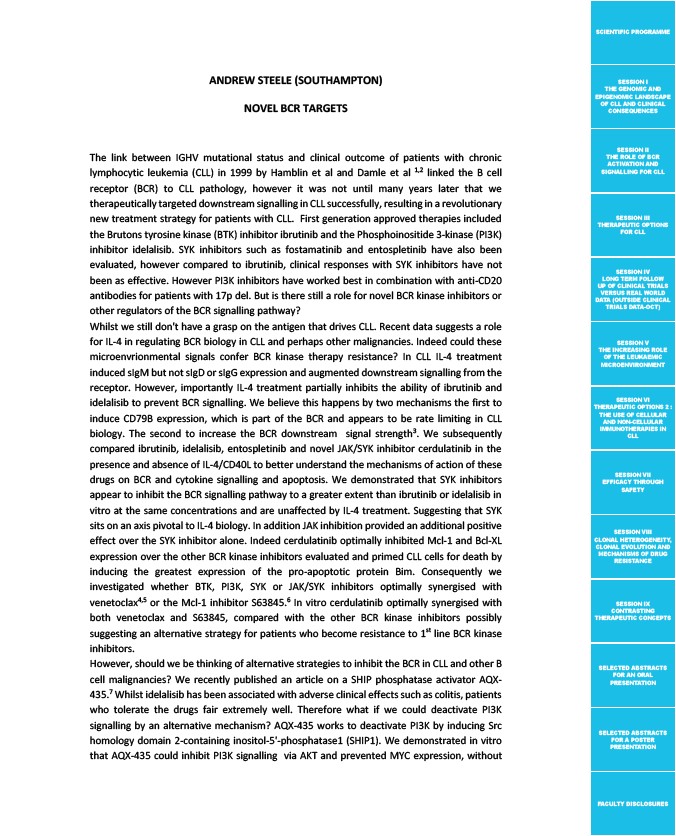
SCIENTIFIC PROGRAMME
SESSION I
THE GENOMIC AND
EPIGENOMIC LANDSCAPE
OF CLL AND CLINICAL
CONSEQUENCES
SESSION II
THE ROLE OF BCR
ACTIVATION AND
SIGNALLING FOR CLL
SESSION III
THERAPEUTIC OPTIONS
FOR CLL
SESSION IV
LONG TERM FOLLOW
UP OF CLINICAL TRIALS
VERSUS REAL WORLD
DATA (OUTSIDE CLINICAL
TRIALS DATA-OCT)
SESSION V
THE INCREASING ROLE
OF THE LEUKAEMIC
MICROENVIRONMENT
SESSION VI
THERAPEUTIC OPTIONS 2 :
THE USE OF CELLULAR
AND NON-CELLULAR
IMMUNOTHERAPIES IN
CLL
SESSION VII
EFFICACY THROUGH
SAFETY
SESSION VIII
CLONAL HETEROGENEITY,
CLONAL EVOLUTION AND
MECHANISMS OF DRUG
RESISTANCE
SESSION IX
CONTRASTING
THERAPEUTIC CONCEPTS
SELECTED ABSTRACTS
FOR AN ORAL
PRESENTATION
SELECTED ABSTRACTS
FOR A POSTER
PRESENTATION
FACULTY DISCLOSURES
ANDREW STEELE (SOUTHAMPTON)
NOVEL BCR TARGETS
The link between IGHV mutational status and clinical outcome of patients with chronic
lymphocytic leukemia (CLL) in 1999 by Hamblin et al and Damle et al 1,2 linked the B cell
receptor (BCR) to CLL pathology, however it was not until many years later that we
therapeutically targeted downstream signalling in CLL successfully, resulting in a revolutionary
new treatment strategy for patients with CLL. First generation approved therapies included
the Brutons tyrosine kinase (BTK) inhibitor ibrutinib and the Phosphoinositide 3-kinase (PI3K)
inhibitor idelalisib. SYK inhibitors such as fostamatinib and entospletinib have also been
evaluated, however compared to ibrutinib, clinical responses with SYK inhibitors have not
been as effective. However PI3K inhibitors have worked best in combination with anti-CD20
antibodies for patients with 17p del. But is there still a role for novel BCR kinase inhibitors or
other regulators of the BCR signalling pathway?
Whilst we still don't have a grasp on the antigen that drives CLL. Recent data suggests a role
for IL-4 in regulating BCR biology in CLL and perhaps other malignancies. Indeed could these
microenvrionmental signals confer BCR kinase therapy resistance? In CLL IL-4 treatment
induced sIgM but not sIgD or sIgG expression and augmented downstream signalling from the
receptor. However, importantly IL-4 treatment partially inhibits the ability of ibrutinib and
idelalisib to prevent BCR signalling. We believe this happens by two mechanisms the first to
induce CD79B expression, which is part of the BCR and appears to be rate limiting in CLL
biology. The second to increase the BCR downstream signal strength3. We subsequently
compared ibrutinib, idelalisib, entospletinib and novel JAK/SYK inhibitor cerdulatinib in the
presence and absence of IL-4/CD40L to better understand the mechanisms of action of these
drugs on BCR and cytokine signalling and apoptosis. We demonstrated that SYK inhibitors
appear to inhibit the BCR signalling pathway to a greater extent than ibrutinib or idelalisib in
vitro at the same concentrations and are unaffected by IL-4 treatment. Suggesting that SYK
sits on an axis pivotal to IL-4 biology. In addition JAK inhibition provided an additional positive
effect over the SYK inhibitor alone. Indeed cerdulatinib optimally inhibited Mcl-1 and Bcl-XL
expression over the other BCR kinase inhibitors evaluated and primed CLL cells for death by
inducing the greatest expression of the pro-apoptotic protein Bim. Consequently we
investigated whether BTK, PI3K, SYK or JAK/SYK inhibitors optimally synergised with
venetoclax4,5 or the Mcl-1 inhibitor S63845.6 In vitro cerdulatinib optimally synergised with
both venetoclax and S63845, compared with the other BCR kinase inhibitors possibly
suggesting an alternative strategy for patients who become resistance to 1st line BCR kinase
inhibitors.
However, should we be thinking of alternative strategies to inhibit the BCR in CLL and other B
cell malignancies? We recently published an article on a SHIP phosphatase activator AQX-
435.7 Whilst idelalisib has been associated with adverse clinical effects such as colitis, patients
who tolerate the drugs fair extremely well. Therefore what if we could deactivate PI3K
signalling by an alternative mechanism? AQX-435 works to deactivate PI3K by inducing Src
homology domain 2-containing inositol-5'-phosphatase1 (SHIP1). We demonstrated in vitro
that AQX-435 could inhibit PI3K signalling via AKT and prevented MYC expression, without